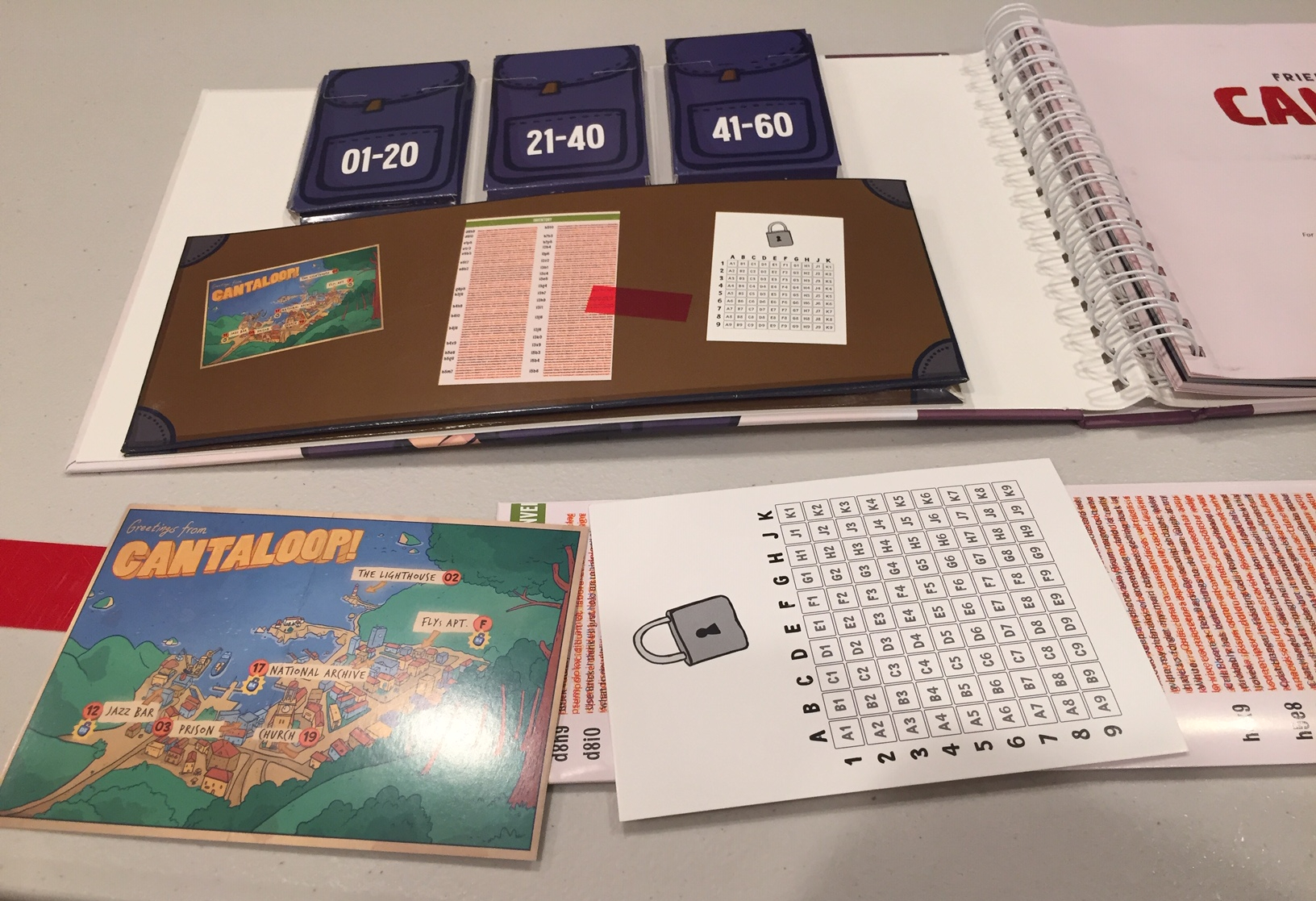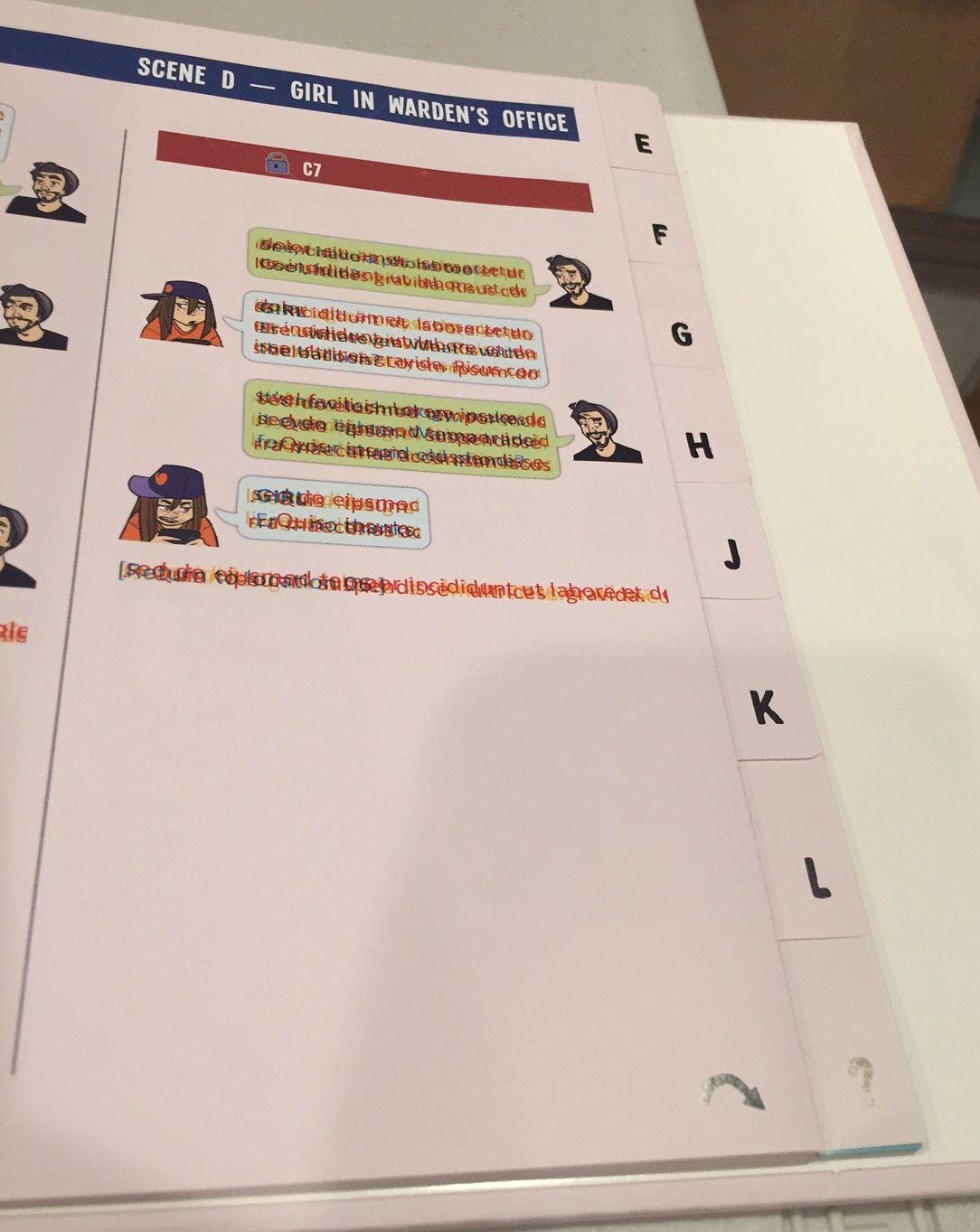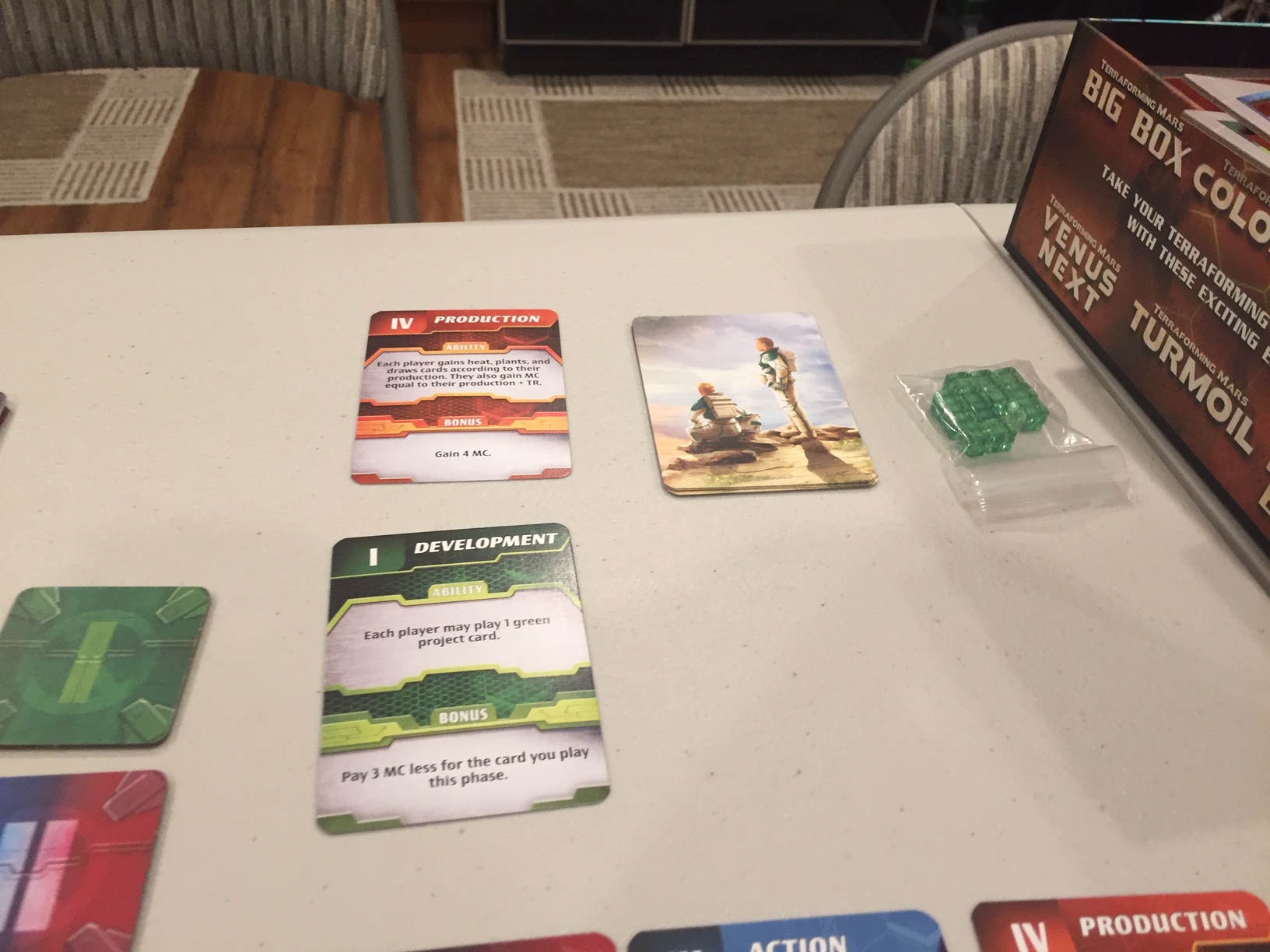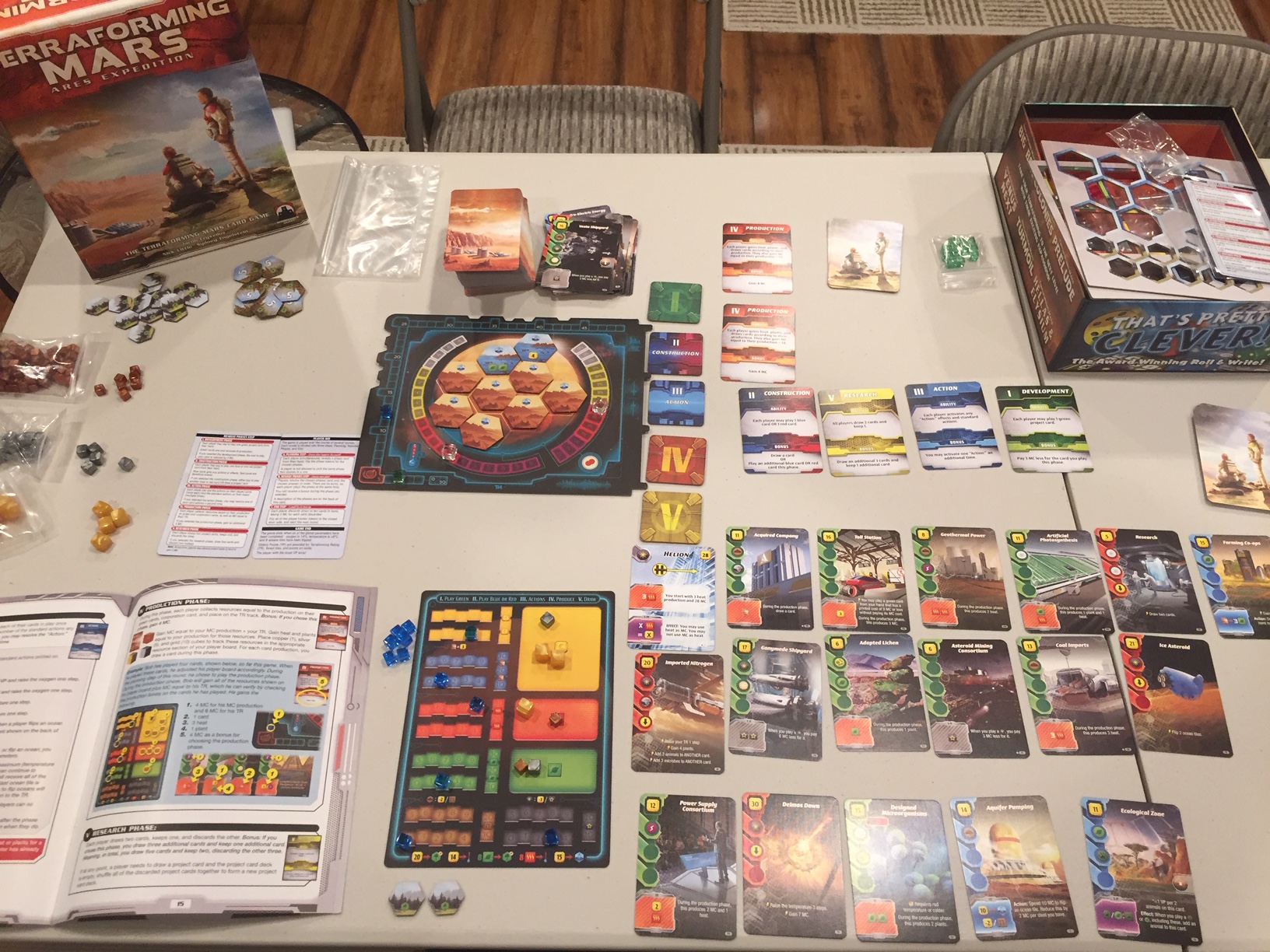Cantaloop is a weird game. It’s labelled (see above) as an Interactive Adventure, but what does that mean? It reminds me of a LucasArts “point-and-click” adventure (like Monkey Island) more than any other board/card game I have played. It’s essentially a solo game, but you can play it cooperatively by having your friends play with you offering suggestions to solve puzzles … much like an Escape Room game (like Unlock or Escape Tales which we reviewed here and here).
The premise of the Cantaloop is that you are trying to recruit a “gang” to help you pull off a revenge heist. One gang member you have coerce from a Jazz club and the other gang member you have to liberate from Prison. If that sounds like this is a dark and brooding game … IT ISN’T!!! This is one of the silliest games I have played in a while (in a good way), but Cantaloop is a thoughtful game in that it presents challenging and interesting puzzles to solve.

Unboxing … or “Book Opening”
So, this isn’t a board game in a conventional box. It’s a book (in shrink wrap) that you have to open! Once you open it up, you see what you get: essentially a book with a few extra components in the front cover: see below.
The components are in some boxes and a flap attached to the front cover.
There are 60 cards over 3 pouches (all labelled cleverly 1-60, see above). The rest of the components are in a pouch under the cards: a map, a postcard, an “trigger matrix” and .. a decoder. The pouch is “labelled” (see above) so you can see what’s in there.
The pouch (see above) is a little cumbersome to get to: you have to force it a little.

Most of the content of the game is in the book itself: the pictures, the text, the story. 
You’ll see that pages (on the right) are physically tabbed so that you can turn to the appropriate section with just a quick motion. Need to get to “07”? It’s easy to just pull the tab and turn the book to that page.
Arguably, the most important piece of the game is the little red “decoder”. Don’t lose this! (We’ll see why later)
Overall, the component are decent: they are kind of cartoony, but that fits the vibe of the game.

The Rulebook … or just the Book!

The book itself is the rulebook: the rules are in the first few pages.
The rulebook starts off with a description of the game and a list of components. It also very clearly delineates when you need to STOP READING as you peruse the rulebook: see below.

Incidentally, I loved the veiled reference to Monkey Island as ape archipelagos (see above): Longtime readers of this blog know that we love Monkey Island (and even put it in our Top 10 Swashbuckling Cooperative games), so this immediately put us in a good mood that this will be a game we like! The component list is lame, but since there are so few components, it’s not a big deal.
The first few pages of the rulebook are a tutorial that takes you through the main mechanisms in the game. It’s a nice tutorial! One of the main ideas of the game is that you will be leafing through the book going from Location to Location (like a point-and-click adventure game): on the left will be some “hidden text” and on the right will be a giant graphic depicting the Location. The Location will be annotated with numbers and letters that will be used to “look” and “investigate” the location (using the text on the right). See the Location 1 below: text on the left, graphic on the right.

To keep the text “hidden” so you don’t accidentally see anything you are supposed to, all the text of the game is “hidden” in garbled red letters that can be decoded using the red decoder: See the hidden text below …

… and then how easy it to read once you use the decoder!

Note: you can read the text ONLY that you want to. If you squint, you CAN read the garbled text above it, but if you are playing honestly, you only read what you are supposed to.
And the game is all about exploring this world! Looking at pictures, correlating items and pictures to figure out what text to read!
Probably the hardest mechanic to get use to is how “items interact with the world”. Each item has a left and right side which numbers/letters on it. You “line up” the items to see if you can use them together.
In the example above, you are using the magnifying glass to look at the cigarette lighter (“look cigarette lighter”). If this is a legal activity, there will be a text blob with that label (in this case r5p5: r5 from the cigarette lighter, p5 from the magnifying glass) you can decode. IF IT IS NOT SOMETHING YOU CAN DO, there will be NO corresponding entry.
What makes this feel like ad Adventure game? Even if combining two items doesn’t make sense, there is typically still a text entry. The game might yell at you (seriously) or make a joke or some oblique reference. Like the old LucasArt adventure games, “clicking” on everything usually reveals something!
Normally, you are combining items with your Location, but sometimes you need to “connect” two items together. If you try to combine two items in your inventory, you have to consult the pamphlet that comes with the game (rather than the Location in the book):
Overall, the introduction to the game serves as a tutorial and does a great job explaining and showing the rules in operation. The mechanism to combine items/Locations is a little wonky, but walking through the tutorial made this very clear how the game mechanisms work.
I have raved about how good the Tainted Grail tutorial is to getting you going right away: the one included here in Cantaloop might be better. It showed you what you CAN do as well as what you CAN’T DO (by giving you funny text if you do something wrong). I was up and going right away in the game. This was a great rulebook/introduction.
Trigger Sheet (Matrix)

One of the more fiddly mechanics in the game is the Trigger Sheet or Trigger Matrix (see above). This isn’t a legacy game, but if you don’t make a copy of the sheet, you will ruin the only copy of the Trigger Sheet so people can’t play the game later. I just got a piece of paper and wrote down “triggers” that I hit as the game went.

What are triggers? They represent you making “progress” in the game! For example, if you combine the batteries and the flashlight, that turns on the flashlight and trigger event H3: you then mark off that H3 on your trigger sheet. (There isn’t actually a flashlight in the game: this is just an example). Later in the game, your text might say:
B3EF: If H3, then read F2D2. Otherwise: “It’s too dark, you can’t see”
F2D2: You can see a light switch on the wall. Lame. I didn’t need the flashlight.
In other words, when you do stuff, the Trigger Sheet notes progress in the game. By the end of the game, most of your Triggers should be marked.
By the way: LEARN FROM MY MISTAKE: you probably should make a copy of the Trigger Sheet and use that … my little piece of paper made it hard to see what Triggers I hit.
Cut Scenes
One my favorite parts of point-and click-adventure games are the cut scenes, when you interact with people you find in the game. For example, in Monkey island, the interactions with Mancomb Seepgood are hilarious as well as informative! (See below).
![Let's Play Secret of Monkey Island - Part 1 [Guybrush meets Mancomb] - YouTube](https://i.ytimg.com/vi/dgZJ7EGzeI4/hqdefault.jpg)
In Cantaloop, the game simulates these cut scenes by going to a particular section of the book (all tabbed out with letters) and following a dialog between two characters.

Of course, depending on Triggers, your interactions will change … you can only see the interaction above if you have hit Trigger C7.
This little touch, the cut scenes, just adds a whole new level to the game for me: it really gives the game personality and story.
NOTE: Locations Tabs are numbers in the game, and Cut Scene Tabs are Letters.
Gameplay
We have to careful here: I don’t want to give away too much. The picture above shows “what are you dealing with” as you play: you’ll have your items (on cards) in front of you, your Inventory chart, and the Location you are currently at. You’ll typically have a bunch of text to read when you visit any new Location, and then you start trying to figure out the puzzles as you go. (“What happens when I combine the bread with the batteries? Anything?”) As you do stuff, you will mark off triggers, read new text, and discover new locations. And lots of jokes Many, many, many jokes.
It took me about 8 hours to get through the whole game. It felt very much like a point-and-click adventure game! Some of the puzzles I got right away, some of the puzzles were a result of “what happens if I combine these items”, some puzzles came to me later as I was exploring, and some puzzles I had to get help on (see later below). I would make manic progress for a while, then get stuck for a while … JUST LIKE AN ADVENTURE GAME. I have played a number of the adventure games in my life, and that’s just the ebb and flow of an adventure game. This captures that ebb and flow perfectly.
This game is all about searching the world of Cantaloop and exploring and combining and solving.
Help System

In the olden days of the original Secret of Monkey Island, (see above) if you needed help in the game, you had a 1-900 telephone number (1-900-740-JEDI) you could call to get help. I am not kidding here: see below! It even cost 75 cents a minute! (This comes from the rulebook of the my Amiga Secret of Monkey Island game!)

The original Monkey Island was released October 15th, 1990, well before the internet had blossomed. There were newsgroups and other things that were uncommon to many people, but nothing like the internet today. (In Monkey Island 2, they even made fun of the 1-900 help line by having Guybrush call it).
Luckily, you don’t have to deal with a 1-900 help line in Cantaloop! There is a help section in the back of the book based on Triggers in the game:

It’s a little messy to get help: you have to look at the Triggers (above) in order until you find one that you HAVE NOT Triggered! The game assumes THAT TRIGGER is where you are stuck (since you haven’t marked it yet). From there, it tells you which number hint to read (using your decoder): see below.

The help system worked for me: it was a little clumsy looking through the Triggers for “the first Trigger you haven’t crossed off”, but most of the time it helped me move forward. They even have Tip #1, Tip #2, and Solution so you don’t have to read the solution straight out if you just want a nudge.
Most of the time, the Help System worked fine, but once or twice it pointed me to a hint that didn’t make sense at first. It’s not the best help system I have found (I think the Unlock or Exit games probably have the better help systems), but this one worked well enough. I didn’t have to call 1-900-740-JEDI to get hints.
Sense of Humor

Cantaloop has a sense of humor! There are SO MANY JOKES littered throughout the game! Sometimes it’s just a straight up joke when you look at something, sometimes it’s a joke when you combine things you can’t REALLY combine, sometimes it’s a very oblique reference! Be warned, the game has some slightly adult content and some jokes and language were more adult than I expected! But, any 13 year old on the playground has heard the language and would probably laugh/get most of the jokes.
This sense of humor was a refreshing change.
Critical Thoughts

I brought Cantaloop with me to the mountains on vacation and played it there. More than I few times, I heard “That looks like a lot of work” from people as I played: I paged through the book, I tried to combine cards, I read text, and I made notes. And you know what? They aren’t wrong! Playing this is a lot more work than other Escape Room games. Unlock and Exit typically have smaller worlds, as they tend to be just 1 hour typically. Cantaloop, which was an 8 hour game for me, there was a lot more stuff to remember and track of! But I say that’s a GOOD THING! The game is interesting enough and long enough to last 8 hours! I was engaged the whole time. Again, I experienced the same ebb and flow as an adventure game! I occasionally had to “walk away” so I clear my head and come back later to the puzzles with a different perspective. I honestly can’t imagine playing this game over one session: It probably took me about 6 sessions to finish the game.
I want to talk about what they got right in the physical components:
- The binding of the book. They got this right. Since the game is all about paging through a book, a lesser or more constricting binding would have soured the game. I never ONCE thought about the binding, which is a sign they got it right. It was easy to page through the book and get to the section I needed.
- The tabs of the book. They got this mostly right. To make a section of the book easy to get to, the book had physical tabs so you could immediately open the book to the section you wanted. I say “mostly” only because they would have slightly better with either a “color coding” (for emphasis) or more “reinforced” tabs (I felt like I might tear the page once or twice). This is a very minor complaint: the tabs worked great.
- The decoder strip. They got this mostly right. It worked, but as I played the little plastic got more and more scratched up. It still worked the whole game but it got slightly harder to read as I played. I think it might have been better to have 2 decoder strips: an extra in case the other gets lost or scratched up.
My only major negative is that you get “tired” of reading the hidden text with the “red decoder”. You have to have a very well lit environment to read the red text well, and sometimes your eyes just get tired of the red. I don’t know how to fix fix that, after all it is the main mechanism of the game, but the red text got to me a few times and I just had to quit for a while.
To be clear: the game is hard. That can be a negative or a positive, depending on your point of view. But, if you are signing up for an 8 hour puzzle-laden experience, expect there to be some difficulty.
Conclusion
Cantaloop is a candidate for Game of the Year for me! I loved this game! The puzzles were interesting and innovative, the plot was engaging, and the sense of humor was ridiculous! The physicality of the game never got in the way of playing: all the physical components were thoughtfully produced to make the adventure flow smoothly. When I was playing Cantaloop, I was engaged and having a good time. When I finished a session, I found myself still thinking about the puzzles and jokes! I would even retell the jokes to my friends! There were, of course, some frustrations (as any adventure game has), but the help system (for all it’s wonkiness) was good enough to keep me from getting stuck.
To this day, I still play The Secret of Monkey Island all over again every few years because I like living in that world! (Even though I have seen all the puzzles) Monkey Island is silly and fun but with interesting puzzles. I think Cantaloop falls into that category of games. The sense of humor and the interesting puzzles make me envy my past self: my past self gets to play this for the first time all over again! Hopefully, I will forget a lot of these puzzles so I can play it again fresh in a few years. Even if I remember a lot of the puzzles, I still look forward to playing again because I enjoyed living in the world so much!
Luckily, there is a sequel planned! Cantaloop is Part I of an ongoing adventure …









:strip_icc()/pic6049083.png)










































































































![Let's Play Secret of Monkey Island - Part 1 [Guybrush meets Mancomb] - YouTube](https://i.ytimg.com/vi/dgZJ7EGzeI4/hqdefault.jpg)














